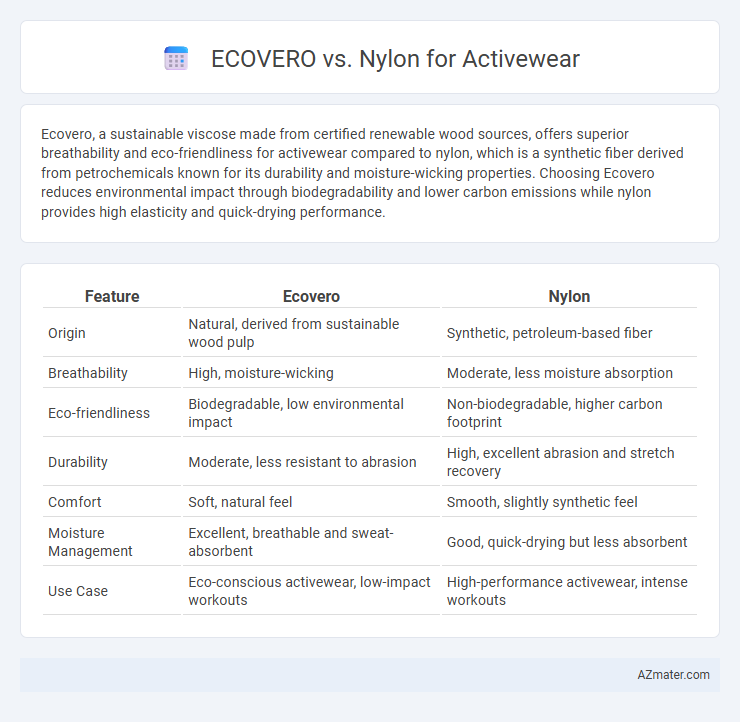Ecovero, a sustainable viscose made from certified renewable wood sources, offers superior breathability and eco-friendliness for activewear compared to nylon, which is a synthetic fiber derived from petrochemicals known for its durability and moisture-wicking properties. Choosing Ecovero reduces environmental impact through biodegradability and lower carbon emissions while nylon provides high elasticity and quick-drying performance.
Table of Comparison
| Feature | Ecovero | Nylon |
|---|---|---|
| Origin | Natural, derived from sustainable wood pulp | Synthetic, petroleum-based fiber |
| Breathability | High, moisture-wicking | Moderate, less moisture absorption |
| Eco-friendliness | Biodegradable, low environmental impact | Non-biodegradable, higher carbon footprint |
| Durability | Moderate, less resistant to abrasion | High, excellent abrasion and stretch recovery |
| Comfort | Soft, natural feel | Smooth, slightly synthetic feel |
| Moisture Management | Excellent, breathable and sweat-absorbent | Good, quick-drying but less absorbent |
| Use Case | Eco-conscious activewear, low-impact workouts | High-performance activewear, intense workouts |
Introduction to Ecovero and Nylon
Ecovero is a sustainable fabric made from certified renewable wood sources, designed to reduce environmental impact through lower water usage and emissions compared to traditional viscose. Nylon, a synthetic polymer derived from petrochemicals, is known for its durability, moisture-wicking properties, and elasticity, making it a popular choice in activewear. While Ecovero offers eco-friendly benefits with a soft, breathable texture, nylon provides superior strength, abrasion resistance, and quick-drying capabilities essential for high-performance sportswear.
Fabric Origins and Production Processes
Ecovero fabric is derived from sustainably sourced wood pulp from certified forests, using a closed-loop production process that minimizes environmental impact by recycling water and solvents. Nylon for activewear originates from petrochemicals through energy-intensive processes involving polymerization and extrusion, often resulting in higher carbon emissions. The eco-friendly production of Ecovero contrasts sharply with the resource-heavy methods used to manufacture conventional nylon fibers.
Sustainability and Environmental Impact
Ecovero fibers, derived from sustainably sourced wood pulp, offer a lower environmental footprint with biodegradable and renewable properties, making them highly favorable for eco-friendly activewear. Nylon, traditionally petroleum-based, poses significant sustainability challenges due to its energy-intensive production process and non-biodegradability, although recycled nylon variants reduce waste and resource consumption. Choosing Ecovero over conventional nylon enhances activewear's sustainability profile by minimizing carbon emissions, water usage, and microplastic pollution.
Comfort and Breathability
Ecovero, a sustainable viscose made from certified renewable wood sources, offers superior breathability and moisture-wicking properties, enhancing comfort during intense workouts. Nylon, a synthetic fiber, provides excellent durability and stretch but tends to trap heat and moisture, which can reduce breathability and cause discomfort. For activewear emphasizing comfort and breathability, Ecovero fabrics outperform nylon by promoting better airflow and temperature regulation.
Moisture-Wicking and Quick-Dry Capabilities
Ecovero fabric, derived from sustainable viscose, offers excellent moisture-wicking properties by efficiently drawing sweat away from the skin, making it suitable for activewear designed for moderate activity levels. Nylon, known for its synthetic fiber strength, excels in quick-dry capabilities and durability, providing superior performance for high-intensity workouts where rapid evaporation of sweat is critical. Choosing between Ecovero and Nylon depends on prioritizing eco-friendly moisture management or maximizing fast-dry technical performance in activewear applications.
Durability and Strength Comparison
Ecovero fibers, derived from sustainable wood sources, offer moderate durability suitable for eco-friendly activewear but may lack the high tensile strength found in nylon. Nylon, a synthetic polymer, is renowned for exceptional durability and resistance to abrasion, making it ideal for high-performance activewear subjected to intense physical activity. When comparing strength, nylon's superior elasticity and tear resistance generally outperform Ecovero, which prioritizes sustainability over extreme durability.
Stretch and Flexibility for Active Use
Ecovero fabric, made from sustainable viscose fibers, offers moderate stretch and breathability suitable for light to medium-intensity activities. Nylon, a synthetic polymer, provides superior elasticity and quick recovery, making it ideal for high-performance activewear requiring maximum stretch and flexibility. For active use demanding durability and enhanced movement, nylon blends typically outperform Ecovero in maintaining shape and comfort during rigorous exercise.
Skin Sensitivity and Allergen Concerns
Ecovero fabric, made from sustainably sourced viscose, offers excellent breathability and moisture-wicking properties, reducing irritation for sensitive skin in activewear. Nylon, a synthetic fiber, often traps heat and moisture, which can exacerbate skin sensitivities and increase the risk of allergic reactions during intense physical activity. Choosing Ecovero-based activewear provides a hypoallergenic option that minimizes skin irritation compared to traditional nylon fabrics.
Maintenance and Care Requirements
Ecovero activewear requires gentle washing in cold water with mild detergent to preserve its sustainable viscose fibers and prevent shrinkage or damage. Nylon activewear demands similar care with cold water washes but benefits from added durability and moisture-wicking properties, though it is prone to pilling if not properly maintained. Both fabrics should be air-dried away from direct sunlight to maintain shape and elasticity, extending the lifespan of the garments.
Cost and Value Analysis
Ecovero fibers typically cost more than nylon due to their eco-friendly production and sustainable sourcing, appealing to brands prioritizing environmental impact. Nylon offers greater affordability and durability, making it a cost-effective option for mass-market activewear while still providing excellent stretch and moisture-wicking properties. Value analysis shows that Ecovero delivers enhanced sustainability and premium marketing potential, whereas nylon maximizes performance and price efficiency in activewear production.

Infographic: Ecovero vs Nylon for Activewear
 azmater.com
azmater.com